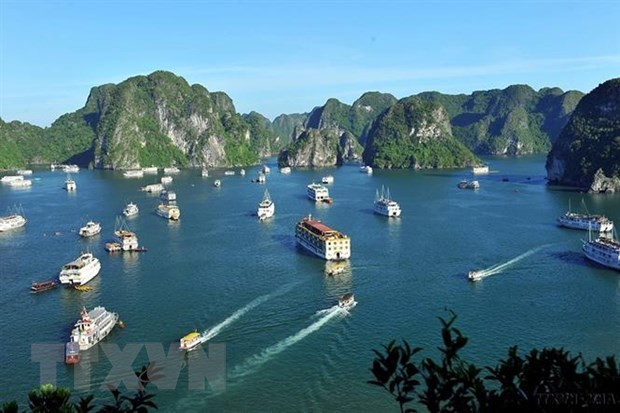 Boats carrying tourists to visit Ha Long Bay, a popular destination in Quang Ninh province (Photo: VNA)
Boats carrying tourists to visit Ha Long Bay, a popular destination in Quang Ninh province (Photo: VNA)The World TourismOrganisation forecast it may take three - four years for the global tourismindustry to return to pre-pandemic levels, and domestic travel is nowconsidered the “lifebuoy” for this sector.
Pham Ngoc Thuy, Director ofthe provincial Tourism Department, said there could be a fierce competitionamong localities to attract visitors, and creating package tours withcompetitive prices may become a common trend.
However, low-priced tourismamid the pandemic could drag this sector down, he warned.
It has taken Quang Ninh manyyears to upgrade infrastructure and develop high-quality tourism products tobecome an international-level destination. If it engages too deeply in the raceto reduce tour and service prices, negative consequences are likely to occursince there won’t be quality products while the province may lose high-qualityhuman resources in this competition, according to the official.
Thuy pointed out that theproblem now is not how to attract tourists but how to maintain travel companies,quality products, and visitors.
There was a time the local tourismindustry just attached importance to the number of tourist arrivals. To improveits contribution to the budget and GRDP of Quang Ninh, development orientationsfor this industry have been changed gradually, with more attention paid torevenue per tourist and profit.
In the current pandemiccontext, provincial leaders have requested that this period of time must be utilisedto complete infrastructure connectivity and seek investors in order to createnew values for the local tourism sector in terms of both quality and infrastructure,Thuy told the Dau tu (Vietnam Investment Review) newspaper.
As one of the businessesactively preparing for their return once the COVID-19 resurgence in put undercontrol, the Tung Lam Development Joint Stock Company has been developing and pilotingnew tourism products that suit the natural features and cultural space of theYen Tu Complex of Monuments and Landscapes, its Deputy General Director Le TrongThanh said.
Pannatour General Director LeThi Nguyet noted after one and a half years of struggling with COVID-19, thetourism sector of Quang Ninh has been reviewing and working to improve productssince the province has yet to succeed in attracting high-end tourists due to ashortage of appropriate services and experiences.
To help address thoseshortcomings, the Sun Group is developing new and high-end products based ontypical values of Quang Ninh.
Apart from the Yoko OnsenQuang Hanh hot spring resort already operational, the firm is building a modernentertainment complex near the Ha Long - Cam Pha coastal road, along with anarea of resort villas in the province.
In particular, once the group’sSun Marina project is completed, Quang Ninh will be the second place in Vietnamto house an international-standard yacht terminal.
Vingroup, another majorinvestor, has also invested in a coastal tourism, service, and urban area complexthat includes luxury villas on different islands and a six-star hotel for travellerswho are ready to spend big.
Director of the Heritage TravelCentre Trinh Thi Mai Anh said her agency has also created new tours with freshexperiences to draw holiday makers, especially domestic ones, to Quang Ninh.
In late June, the TourismPromotion Information Centre, part of the provincial Tourism Department, coordinatedwith the Heritage Travel Centre to arrange 25 tours for travellers to visitlocalities across Quang Ninh.
Meanwhile, the Vietyacht Co.Ltd, specialised in yacht services on Ha Long Bay, is also making use of the pandemic-causedperiod of operation suspension to give more training to its personnel and carryout digitalisation so as to stay ready to seize new opportunities.
Quang Ninh is endowed with natural advantagesfor sea and island tourism. It has a coastline of more than 250 kilometres andmore than 2,000 islands and islets which account for two-thirds of the totalnumber in Vietnam.
It is home to popular destinations such as HaLong Bay, Bai Tu Long, Ha Long Bay National Park and some islands.
In particular, Ha Long Bay was recognised twiceas a World Natural Heritage site by UNESCO, in 1994 and 2000./.





























